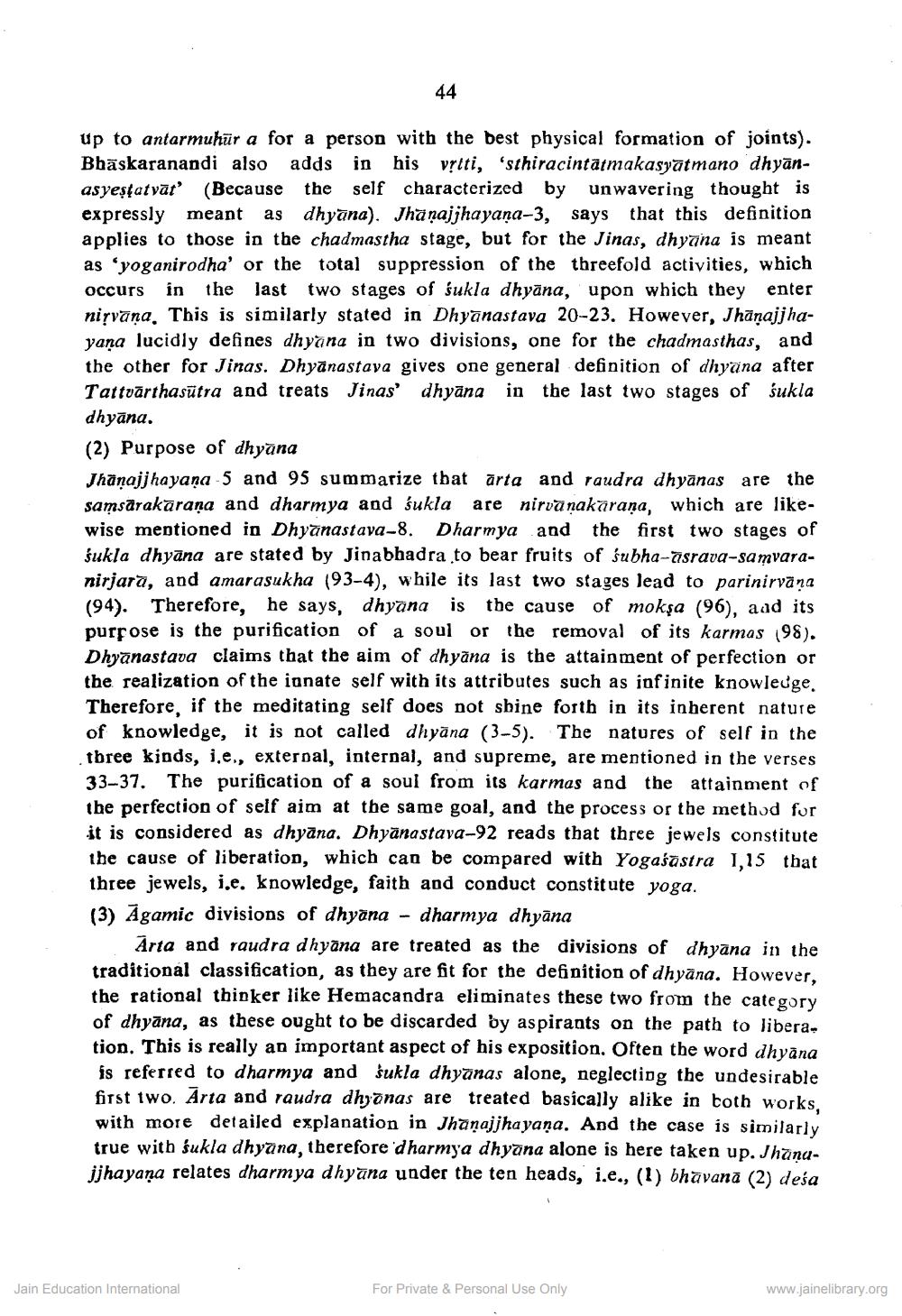________________
44
up to antarmuhur a for a person with the best physical formation of joints). Bhaskaranandi also adds in his vṛtti, 'sthiracintātmakasyātmano dhyānasyeṣṭatvāt' (Because the self characterized by unwavering thought is expressly meant as dhyana). Jhaṇajjhayaṇa-3, says that this definition applies to those in the chadmastha stage, but for the Jinas, dhyana is meant as 'yoganirodha' or the total suppression of the threefold activities, which Occurs in the last two stages of sukla dhyana, upon which they enter nirvana. This is similarly stated in Dhyānastava 20-23. However, Jhaṇajjhayana lucidly defines dhyana in two divisions, one for the chadmasthas, and the other for Jinas. Dhyānastava gives one general definition of dhyana after Tattvärthasutra and treats Jinas' dhyana in the last two stages of sukla dhyāna.
(2) Purpose of dhyana
Jhaṇajjhayana 5 and 95 summarize that arta and raudra dhyānas are the samsarakarana and dharmya and sukla are nirvanakaraṇa, which are likewise mentioned in Dhyanastava-8. Dharmya and the first two stages of sukla dhyana are stated by Jinabhadra to bear fruits of subha-asrava-samvaranirjara, and amarasukha (93-4), while its last two stages lead to parinirvāṇa (94). Therefore, he says, dhyana is the cause of mokṣa (96), aad its purpose is the purification of a soul or the removal of its karmas (98). Dhyanastava claims that the aim of dhyana is the attainment of perfection or the realization of the innate self with its attributes such as infinite knowledge. Therefore, if the meditating self does not shine forth in its inherent nature of knowledge, it is not called dhyāna (3-5). The natures of self in the three kinds, i,e,, external, internal, and supreme, are mentioned in the verses 33-37. The purification of a soul from its karmas and the attainment of the perfection of self aim at the same goal, and the process or the method for it is considered as dhyana. Dhyanastava-92 reads that three jewels constitute the cause of liberation, which can be compared with Yogaśastra 1,15 that three jewels, i.e. knowledge, faith and conduct constitute yoga. (3) Agamic divisions of dhyana dharmya dhyana
Arta and raudra dhyana are treated as the divisions of dhyana in the traditional classification, as they are fit for the definition of dhyana. However, the rational thinker like Hemacandra eliminates these two from the category of dhyana, as these ought to be discarded by aspirants on the path to liberation. This is really an important aspect of his exposition. Often the word dhyana is referred to dharmya and ŝukla dhyanas alone, neglecting the undesirable first two. Arta and raudra dhyanas are treated basically alike in both works, with more detailed explanation in Jhanajjhayaṇa. And the case is similarly true with śukla dhyana, therefore dharmya dhyana alone is here taken up. Jhanajjhayana relates dharmya dhyana under the ten heads, i.e., (1) bhāvanā (2) desa
Jain Education International
For Private & Personal Use Only
www.jainelibrary.org




